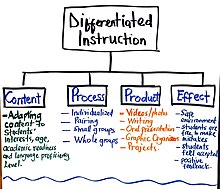User:Genipet/Differentiated instruction
| This is the sandbox page where you will draft your initial Wikipedia contribution.
If you're starting a new article, you can develop it here until it's ready to go live. If you're working on improvements to an existing article, copy only one section at a time of the article to this sandbox to work on, and be sure to use an edit summary linking to the article you copied from. Do not copy over the entire article. You can find additional instructions here. Remember to save your work regularly using the "Publish page" button. (It just means 'save'; it will still be in the sandbox.) You can add bold formatting to your additions to differentiate them from existing content. |
Article Draft[edit]
Lead[edit]
In recent years there has been calls for educational reforms. One of the areas that is getting a lot of attention is differentiation of instruction due greatly to the widening categories of the students and more research showing the one-cap-fits-all design no longer holds when it comes to instruction. I chose this article because it is still under construction and as a teacher, I wanted to read more about what others have to say about differentiated instruction and add my studies to it.
Article body[edit]
Differentiated instruction and assessment, also known as differentiated learning or, in education, simply, differentiation, is a framework or philosophy for effective teaching that involves providing all students within their diverse classroom community of learners a range of different avenues for understanding new information (often in the same classroom) in terms of: acquiring content; processing, constructing, or making sense of ideas; and developing teaching materials and assessment measures so that all students within a classroom can learn effectively, regardless of differences in their ability. Students vary in culture, socioeconomic status, language, gender, motivation, ability/disability, learning styles, personal interests and more, and teachers must be aware of these varieties as they plan in accordance with the curricula. According to Boelens et al. (2018), differentiation can be on two different levels. 1. The administration level which takes the socioeconomic status, and gender into consideration and 2. The classroom level. At the classroom level, differentiation revolves around content, processing, product, and effects. On the content level, teachers adapt what they are teaching to meet the needs of students. This can mean making content more challenging or simplified for students based on their levels. The process of learning can be differentiated as well. Teachers may choose to teach individually at a time, assign problems to small groups, partners or the whole group depending on the needs of the students. By differentiating product, teachers decide how students will present what they have learnt. This may take the form of videos, graphic organizers, photo presentations, writing, and oral presentations. All these takes place in a safe classroom environment where students fell repeated and values - effects.[1]

By considering varied learning needs, teachers can develop personalized instruction so that all children in the classroom can learn effectively. When language is the factor for differention, Echevarria et al. (2017), proponents of the Sheltered Instruction Observation Protocol (SIOP) strongly supports and guides teachers to differentiate instruction to English as a Second Language Learners (ELLs) who have a range of learning ability levels - Beginning, intermediate and advanced. Here, differentiated instruction will mean adapting a whole new instructional strategy that a teacher of a typical classroom of native speakers of English would not have a need to.[2]
Differentiated classrooms have also been described as the ones that respond to student variety in readiness levels, interests, and learning profiles. It is a classroom that includes and allows all students to be successful. To do this, a teacher sets different expectations for task completion for students, specifically based upon their individual needs.
Differentiated instruction, according to Carol Ann Tomlinson, is the process of "ensuring that what a student learns, how he or she learns it, and how the student demonstrates what he or she has learned is a match for that student's readiness level, interests, and preferred mode of learning." Teachers can differentiate in four ways: 1) through content, 2) process, 3) product, and 4) learning environment based on the individual learner. Differentiation stems from beliefs about differences among learners, how they learn, learning preferences, and individual interests (Algozzine & Anderson, 2007). Therefore, differentiation is an organized, yet flexible way of proactively adjusting teaching and learning methods to accommodate each child's learning needs and preferences to achieve maximum growth as a learner. To understand how students learn and what they know, pre-assessment and ongoing assessment are essential. This provides feedback for both teacher and student, with the ultimate goal of improving student learning. Delivery of instruction in the past often followed a "one size fits all" approach. In contrast, differentiation is individually student centered, with a focus on appropriate instructional and assessment tools that are fair, flexible, challenging, and engage students in the curriculum in meaningful ways.
References[edit]
- ^ Boelens, Ruth; Voet, Michiel; De Wever, Bram (2018-05-01). "The design of blended learning in response to student diversity in higher education: Instructors' views and use of differentiated instruction in blended learning". Computers & Education. 120: 197–212. doi:10.1016/j.compedu.2018.02.009. ISSN 0360-1315.
- ^ Echevarría, Vogt & Short, J; Vogt, M; Short, D (2017). Making content comprehensible for English learners: The SIOP model (5th ed.). Pearson.
